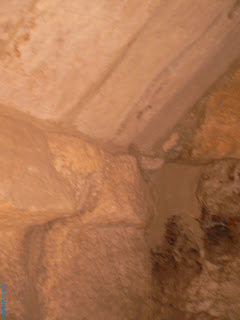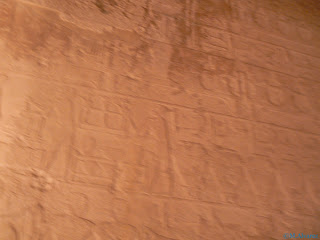Silver Vase from Tutankhamun's Tomb
Cairo Museum
http://www.museumsyndicate.com
|
sábado, 29 de abril de 2017
DAGGER
Present location RIJKSMUSEUM VAN OUDHEDEN [06/001] LEIDEN
Inventory number AB 138
Dating 18TH DYNASTY (not before); 26TH DYNASTY (not after)
Archaeological Site UNKNOWN
Category DAGGER
Material BRONZE; GOLD; IVORY
Technique HAMMERING; INLAY
globalegyptianmuseum.org
Bibliography•Leemans, C., Aegyptische Monumenten van het Nederlandse Museum van Oudheden te Leiden II, Leiden 1853, 14, pl. LXXXII, 70.
Funeral portrait of a woman
| Title | Funeral portrait of a woman |
| Object type | Painting |
| Date | (200 - 230) |
| Dimensions | Height: 640 mm (25.2 in). Width: 380 mm (14.96 in). |
| Current location |
Temple of Hatshepsut, Thebes
Temple of Hatshepsut, Thebes
Egypt
1923–1931
Background
Hatshepsut was the most significant of Egypt's female rulers. She came
to power early in Dynasty 18, at the beginning of the New Kingdom. First
as regent, then as co-ruler with her stepson and nephew, Thutmose III,
Hatshepsut wielded the authority of king for more than twenty years (ca.
1479–1458 B.C.).
The crowning architectural achievement of Hatshepsut's reign was her
terraced funerary temple, Djeser-djeseru, at Deir el-Bahri in western
Thebes opposite modern Luxor. The temple, with its three levels of
pillared porticoes, combined building, sculpture, and landscape in one
of the world's great architectural masterpieces. Djeser-djeseru was
partly inspired by a neighboring temple built five centuries earlier for
Mentuhotep II, founder of the Middle Kingdom. By associating herself
with Mentuhotep, one of Egypt's greatest rulers, Hatshepsut reinforced
her own position as king.
Hatshepsut revitalized the royal funerary complex by combining her
mortuary cult with a temple of the gods. Chief among the deities
worshipped at Djeser-djeseru was Amun, whose principal temple, Karnak,
was at Thebes, on the east bank of the Nile. Amun's chapel dominates the
central axis of Djeser-djeseru, and once a year, during the "Beautiful
Feast of the Valley," the god's image was brought from Karnak, in a
boat-shaped shrine, to rest in Hatshepsut's temple.
Although Djeser-djeseru was partly destroyed by falling rock from the
cliffs above, it was never completely buried. In the seventh century
A.D., a Coptic monastery of mudbrick was constructed on the ruins of the
upper terrace and, centuries later, the ruined monastery inspired the
name of the site, Deir el-Bahri (northern monastery).
Excavations
The temples of Hatshepsut and Mentuhotep II were well known when the
Metropolitan Museum's excavators, led by Museum Egyptologist Herbert E.
Winlock, began clearing the area in front of them in 1923. Winlock was
searching for information about the early Middle Kingdom when he began
finding fragments of statues belonging to the time of Hatshepsut. Some
were pieces of limestone sculpture that had been part of the temple
architecture. These giant images of Hatshepsut had once decorated the
portico and niches of the upper terrace. Other fragments of granite and
sandstone came from huge sphinxes and freestanding statues of Hatshepsut
that had lined the processional way leading to the sanctuary of Amun.
The sculpture had been destroyed some twenty years after Hatshepsut's
death by her nephew, Thutmose III, for reasons that still are not
completely understood.
Between
1923 and 1931, tens of thousands of fragments—some weighing more than a
ton, others smaller than a human fist—were recovered and sorted.
Examples of the architectural statues were reattached to the temple's
facade and some of the sphinxes and other freestanding statues were
reassembled and divided between the Egyptian Antiquities Service and the
Metropolitan Museum. Objects acquired by the Museum in this division of
finds are on view in Egyptian galleries 115, 116, and 117.
Met Museum
viernes, 21 de abril de 2017
portrait
Museum number
EA74709
Description
Full: Front
Portrait on a linen shroud: though the figure is painted in tempera, the hair appears waxy and was apparently painted in encaustic. The fragmentary linen shroud has been remounted, and much of the paint is abraded. The jewellery was added in gold leaf. The surface is coated with varnish. The woman wears a green tunic with black clavi. Unusually she has no mantle. Her right arm is raised across her body and holds a pinkish-red lucky knot; her left arm rests beneath. In her hair the woman wears a red band, an ornament characteristic of Neronian portraits. The central parting is gilded. In her pierced ears the woman wears ball earrings typical of the later first century AD, and round her neck is a necklace of gold beads linked by cylindrical elements, with a central shell pendant. On both forearms are gold snake bracelets. On the third finger of her right hand is a gold ring, now mostly lost. The hair is lightly waved with banks of curls at the sides of the head, and long locks at the side of the neck, that on the proper left side worn in a knot of the sort more often seen at the nape of the neck, here bound in gold. The eyes are large and round, with eyebrows and eyelashes drawn with individual strokes resembling stitches, very characteristic of painting in tempera. The slightly opened lips are painted red, and there are cream highlights on the nose.
© The Trustees of the British Museum
britishmuseum.org
Women
‘Mourning women and decorum in ancient Egyptian art’, pp. 156–62 in E. Frood and A. McDonald (eds), Decorum and Experience: Essays in Ancient Culture for Prof. John Baines. Oxford: Griffith Institute, 2013.
https://www.academia.edu/12439669/_Mourning_women_and_decorum_in_ancient_Egyptian_art_pp._156_62_in_E._Frood_and_A._McDonald_eds_Decorum_and_Experience_Essays_in_Ancient_Culture_for_Prof._John_Baines._Oxford_Griffith_Institute_2013
martes, 18 de abril de 2017
lunes, 17 de abril de 2017
Ancient Egypt: An Introduction
Ancient Egypt: An Introduction
by Salima Ikram
This book provides an introduction to one of the greatest civilization of all time - ancient Egypt. Beginning with a geographical overview that explains the development of Egyptian belief systems as well as its subsequent political development, it examines methodology, the history of the discipline of Egyptology, religion, social organization, urban and rural life, and death. It also includes a section on how people of all ranks lived. Lavishly illustrated, with many unusual photographs of rarely seen sites that are seldom illustrated, this volume is suitable for use in introductory-level courses on ancient Egypt. It offers a variety of student-friendly features, including a glossary, a bibliography, and a list of sources for those who wish to further their interest in ancient Egypt
ISBN-13: 978-0521675987
ISBN-10: 0521675987
The Literature of Ancient Egypt: An Anthology of Stories, Instructions, Stelae, Autobiographies, and Poetry
The Literature of Ancient Egypt: An Anthology of Stories, Instructions, Stelae, Autobiographies, and Poetry; Third Edition Paperback – October 11, 2003
by William Kelley Simpson
The latest edition of this highly praised anthology of ancient Egyptian literature offers fresh translations of all the texts as well as some twenty-five new entries, including writings from the late literature of the Demotic period at the end of classical Egyptian history. The book also includes an extensive bibliography.
Publisher: Yale University Press; 3rd Revised & enlarged edition (October 11, 2003)
Language: English
ISBN-10: 0300099207
ISBN-13: 978-0300099201
domingo, 16 de abril de 2017
Suscribirse a:
Entradas (Atom)







































































